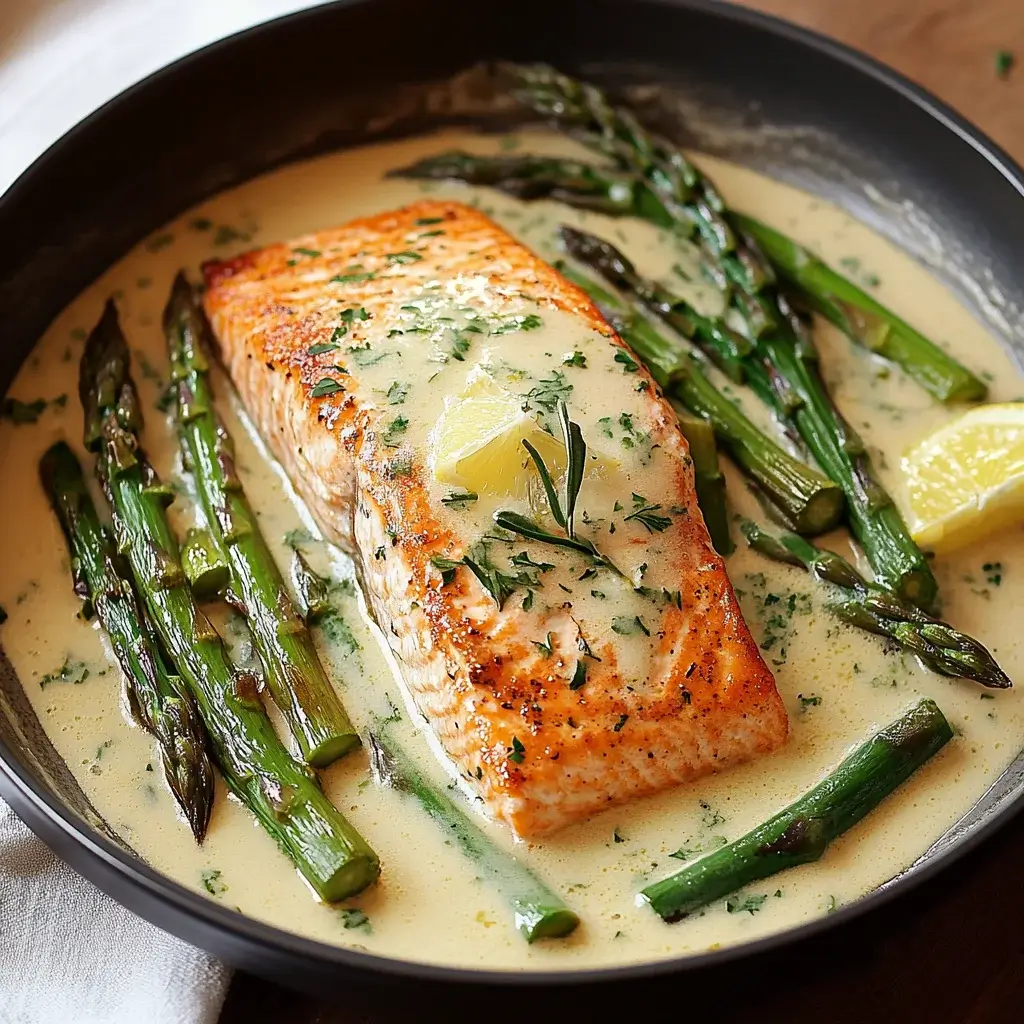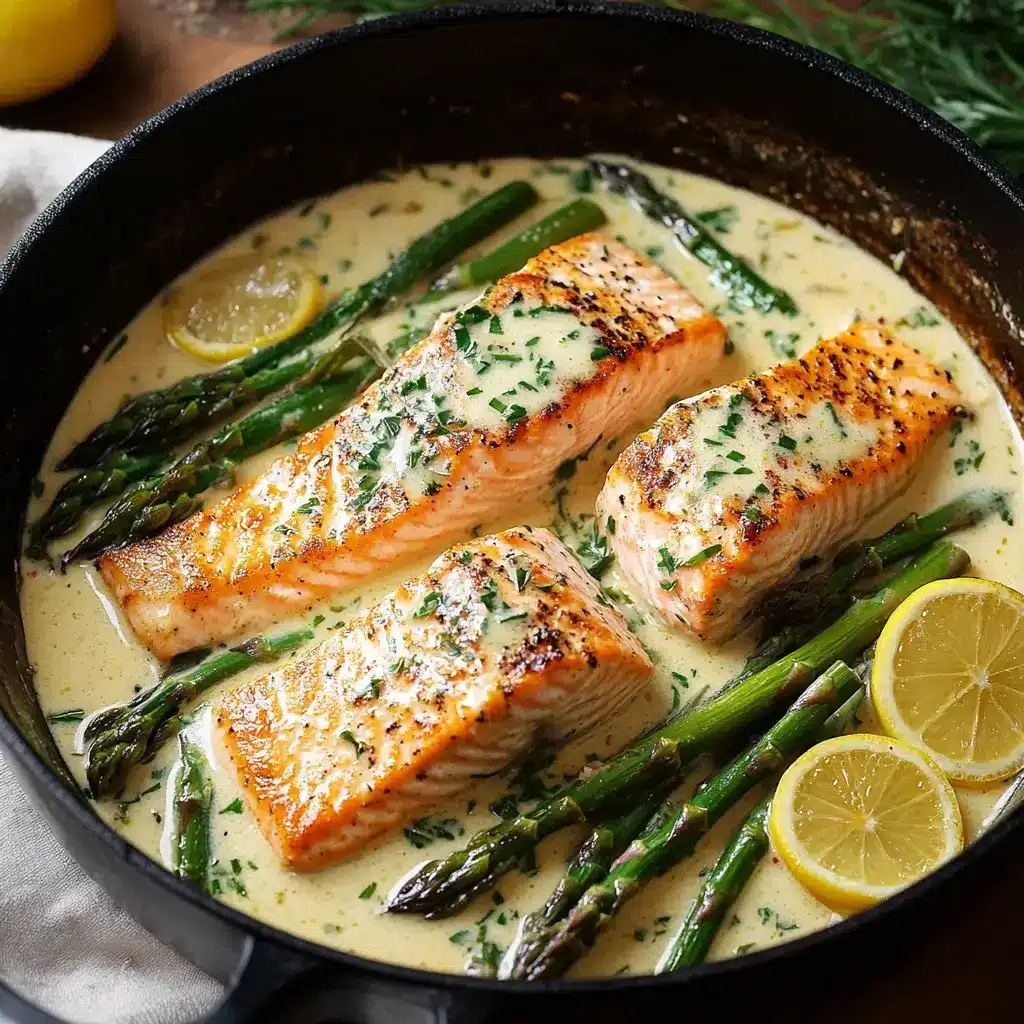
Introduction to Creamy Spring Salmon with Asparagus
There’s something magical about springtime, isn’t there? The air is fresh, flowers bloom, and the days grow longer. It’s the perfect season to whip up a delightful dish like Creamy Spring Salmon with Asparagus.
This recipe is not just a meal; it’s a celebration of flavors and colors that can brighten any busy day. Whether you’re looking to impress your loved ones or simply treat yourself, this dish is quick and easy to prepare.
With tender salmon and vibrant asparagus, it’s a wholesome choice that brings the essence of spring right to your table.
Why You’ll Love This Creamy Spring Salmon with Asparagus
This Creamy Spring Salmon with Asparagus is a game-changer for your weeknight dinners.
It’s not just about the taste—though the rich, creamy sauce and tender salmon are hard to resist.
The beauty lies in its simplicity.
In just 30 minutes, you can serve a restaurant-quality meal that feels special.
Plus, it’s packed with nutrients, making it a guilt-free indulgence you’ll want to repeat.
Ingredients for Creamy Spring Salmon with Asparagus
Creating this Creamy Spring Salmon with Asparagus is a breeze, especially with the right ingredients. Here’s what you’ll need to bring this dish to life:
- Salmon fillets: Fresh, high-quality salmon is key. Look for vibrant color and a firm texture.
- Olive oil: A drizzle adds richness and helps the salmon crisp up beautifully.
- Salt and black pepper: Essential for seasoning, enhancing the natural flavors of the salmon.
- Asparagus: Tender and bright green, asparagus adds a lovely crunch and a pop of color.
- Heavy cream: This is what makes the sauce creamy and luxurious. For a lighter option, consider Greek yogurt.
- Chicken broth: Adds depth to the sauce. You can use vegetable broth for a vegetarian twist.
- Dijon mustard: A touch of tanginess that elevates the flavor profile of the dish.
- Lemon juice: Freshly squeezed lemon juice brightens the dish and balances the creaminess.
- Dill: Fresh dill brings a fragrant herbaceous note. Dried dill works too if fresh isn’t available.
- Parmesan cheese: Grated Parmesan adds a savory finish, melting beautifully over the salmon.
For exact measurements, check the bottom of the article where you can find everything listed for easy printing.
Feel free to get creative! You can toss in cherry tomatoes or spinach for extra color and nutrients. The beauty of this dish lies in its versatility, so don’t hesitate to make it your own.
How to Make Creamy Spring Salmon with Asparagus
Cooking this Creamy Spring Salmon with Asparagus is a delightful journey.
Let’s break it down into simple steps that will have you feeling like a culinary pro in no time.
Step 1: Preheat the Oven
Start by preheating your oven to 400°F (200°C).
This step is crucial because it ensures even cooking.
While the oven heats up, line a baking sheet with parchment paper.
This makes cleanup a breeze and prevents the salmon from sticking.
Step 2: Prepare the Salmon
Next, place the salmon fillets on the prepared baking sheet.
Drizzle them with olive oil, which adds flavor and helps achieve that perfect crisp.
Sprinkle salt and black pepper generously over the fillets.
This simple seasoning enhances the natural taste of the salmon, making it shine.
Step 3: Sauté the Asparagus
In a skillet over medium heat, add a splash of olive oil and toss in the asparagus.
Sauté for about 3-4 minutes until they’re tender but still crisp.
You want that vibrant green color to pop!
This quick cooking method keeps the asparagus crunchy and full of flavor.
Step 4: Make the Cream Sauce
In a small saucepan, combine heavy cream, chicken broth, Dijon mustard, lemon juice, and dill.
Heat this mixture over low heat, stirring occasionally until warmed through.
This creamy sauce is the heart of the dish, bringing everything together with its rich flavor.
Step 5: Assemble the Dish
Now it’s time to layer the ingredients.
Pour the cream sauce over the salmon fillets, letting it cascade down.
Arrange the sautéed asparagus around the salmon, and sprinkle grated Parmesan cheese on top.
This adds a savory finish that melts beautifully during baking.
Step 6: Bake the Salmon
Slide the baking sheet into the preheated oven and bake for 15-20 minutes.
Keep an eye on the salmon; it’s done when it flakes easily with a fork.
Timing is key here—overcooking can dry it out, so check for doneness around the 15-minute mark.
Once ready, serve immediately and enjoy the burst of spring flavors!

Tips for Success
- Use fresh salmon for the best flavor and texture.
- Don’t skip preheating the oven; it ensures even cooking.
- For a creamier sauce, let it simmer gently without boiling.
- Check the salmon at 15 minutes to avoid overcooking.
- Feel free to experiment with herbs like parsley or tarragon for a twist.
Equipment Needed
- Baking sheet: A standard sheet works, but a cast iron skillet can add a nice sear.
- Parchment paper: Use aluminum foil if you don’t have parchment; it’ll still prevent sticking.
- Skillet: Any non-stick skillet will do for sautéing the asparagus.
- Small saucepan: A regular saucepan is perfect for making the cream sauce.
- Spatula: A silicone spatula is great for mixing and serving.
Variations
- Herb-Infused: Swap dill for fresh basil or tarragon for a different flavor profile.
- Spicy Kick: Add a pinch of red pepper flakes to the cream sauce for a bit of heat.
- Vegetarian Option: Replace salmon with firm tofu or portobello mushrooms for a plant-based twist.
- Low-Carb Delight: Serve over zucchini noodles instead of traditional pasta for a lighter meal.
- Cheesy Variation: Mix in some crumbled feta cheese with the asparagus for an extra layer of flavor.
Serving Suggestions
- Side Salad: Pair with a light arugula salad dressed in lemon vinaigrette for a refreshing contrast.
- Wine Pairing: A chilled Sauvignon Blanc complements the creamy salmon beautifully.
- Presentation: Serve on a colorful plate, garnished with extra dill and lemon wedges for a pop of color.
FAQs about Creamy Spring Salmon with Asparagus
Can I use frozen salmon for this recipe?
Absolutely! Just make sure to thaw it completely before cooking. Frozen salmon can be just as delicious when prepared correctly.
What can I substitute for heavy cream?
If you’re looking for a lighter option, Greek yogurt works well. You can also use coconut cream for a dairy-free alternative.
How do I know when the salmon is done?
The salmon is perfectly cooked when it flakes easily with a fork and has an internal temperature of 145°F (63°C). Keep an eye on it around the 15-minute mark!
Can I add other vegetables to this dish?
Definitely! Cherry tomatoes, spinach, or even bell peppers can add color and nutrients. Just sauté them along with the asparagus.
Is this dish suitable for meal prep?
Yes! You can prepare the salmon and sauce ahead of time. Just store them separately in the fridge and bake when you’re ready to eat.
Final Thoughts
Cooking Creamy Spring Salmon with Asparagus is more than just preparing a meal; it’s about creating a moment.
The vibrant colors and rich flavors bring the essence of spring right to your table, making every bite a celebration.
Whether you’re sharing it with family or enjoying a quiet dinner alone, this dish offers warmth and comfort.
It’s quick, easy, and packed with nutrients, making it a perfect choice for busy weeknights.
So, roll up your sleeves, embrace the joy of cooking, and let this delightful recipe brighten your dining experience!
Creamy Spring Salmon with Asparagus: A Must-Try Delight!
Ingredients
Method
- Preheat your oven to 400°F (200°C). Line a baking sheet with parchment paper.
- Place the salmon fillets on the prepared baking sheet. Drizzle with olive oil and season with salt and pepper.
- In a skillet over medium heat, sauté the asparagus for about 3-4 minutes until tender but still crisp. Remove from heat and set aside.
- In a small saucepan, combine the heavy cream, chicken broth, Dijon mustard, lemon juice, and dill. Heat over low heat until warmed through, stirring occasionally.
- Pour the cream mixture over the salmon fillets. Sprinkle the sautéed asparagus around the salmon and top with grated Parmesan cheese.
- Bake in the preheated oven for 15-20 minutes, or until the salmon is cooked through and flakes easily with a fork.
- Serve immediately, garnished with additional dill if desired.
Nutrition
Notes
- For a lighter version, substitute half of the heavy cream with Greek yogurt.
- Add cherry tomatoes or spinach to the asparagus for extra color and nutrients.

